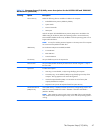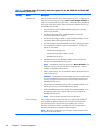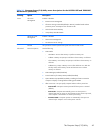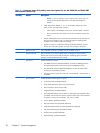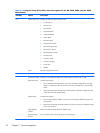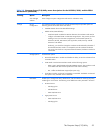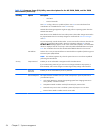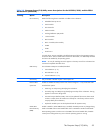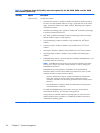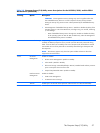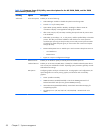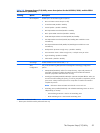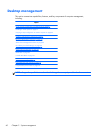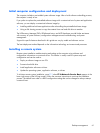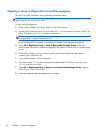
Table 2-2 Computer Setup (F10) Utility menu descriptions for the HP Z420, Z620, and the Z820
Workstations (continued)
Heading Option Description
Device Security Makes the following devices available or hidden to the workstation:
●
Embedded Security Device
●
SAS Controller
●
SCU Controller
●
USB3 Controller
●
Intel High Definition (HD) Audio
●
1394 Controller
●
NIC Controller
●
NIC1 Controller (select models)
●
SATA0
●
SATA1
●
Serial Port A
For each device, Device Available is the default setting and allows the operating system to
access the device. Device Hidden makes the device unavailable; it is disabled by the BIOS
and cannot be enabled by the operating system.
NOTE: An entry for enabling DriveLock appears in the setup menu if the workstation has
a DriveLock-compatible hard disk drive.
USB Security Set workstation USB ports to Enabled/Disabled:
●
Front USB Ports—(1–3)
●
Rear USB Ports—(1–6)
●
Internal USB Ports—(1–6)
Slot Security Lets you enable or disable any PCI or PCI Express slot.
Network Boot Enables or disables the ability to boot to the network using the F12 key or the boot order.
System IDs Provides these options:
●
Asset Tag—A 16-byte string identifying the workstation.
●
Ownership Tag—An 80-byte string identifying ownership of the workstation. This tag
appears on the screen during POST.
●
Universal Unique Identifier (UUID)—Can only be updated if the current chassis serial
number is invalid. (These ID numbers are normally set in the factory and are used to
uniquely identify the workstation.)
●
Keyboard—Enables you to set the keyboard locale for System ID entry.
Master Boot
Record Security
(MBR)
Enable or Disable—When MBR Security is enabled, the BIOS prevents any changes being
made to the MBR of the current bootable disk while in MS-DOS or Windows Safe Mode.
Most operating systems control access to the MBR of the current bootable disk; the BIOS
cannot prevent changes that may occur while the operating system is running.
The Computer Setup (F10) Utility
55



